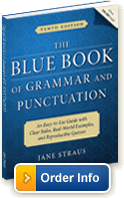|
Welcome to your GrammarBook.com E-Newsletter.

"Your newsletters are invaluable."
- Debra P.
"Word is spreading about how great your book is and the things you have available on the Web."
- Natalie F.
"Thank you for the site! Itís very useful."
- Phil B.
"I just ordered your Blue Book of Grammar and Punctuation. Thanks for writing it. I love receiving the newsletter with mini-lessons!"
- Brianne U.
|
|
|
Using Commas, Semicolons, and Colons within Sentences
Punctuation within sentences can be tricky; however, if you know just a few of the following rules, you will be well on your way to becoming a polished writer and proofreader.
Rule: Use a comma between two long, independent clauses when conjunctions such as and, or, but, for, nor connect them.
Example: I have painted the entire house, but she is still working on sanding the floors.
Rule: If the clauses are both short, omit the comma.
Example: I painted and he sanded.
Rule: If you have only one clause (one subject and verb pair), do not use a comma in front of the conjunction.
Example: I have painted the house but still need to sand the floors.
This sentence has two verbs but only one subject, so it has only one clause.
Rule: Use the semicolon if you have two independent clauses connected without a conjunction.
Example: I have painted the house; I still need to sand the floors.
Rule: Also use the semicolon when you already have commas within a sentence for smaller separations, and you need the semicolon to show bigger separations.
Example: We had a reunion with family from Salt Lake City, Utah; Los Angeles, California; and Albany, New York.
Rule: A colon is used to introduce a second sentence that clarifies the first sentence.
Example: We have set this restriction: do your homework before watching television.
Notice that the first word of the second sentence is not capitalized. If, however, you have additional sentences following the sentence with the colon and they explain the sentence prior to the colon, capitalize the first word of all the sentences following the colon.
Rule: Use a colon to introduce a list when no introductory words like namely, for instance, i.e., e.g. precede the list.
Example: I need four paint colors: blue, gray, green, and red.
Due to the E-Newsletter's large readership, we are unable to respond to individual English usage questions. |
|
Free BONUS Quiz For You!
[[firstname]], because you are a subscriber to the newsletter, you get access to one of the Subscription Members-Only Quizzes. Click here to take a Commas Quiz and get your scores and explanations instantly!

"So convenient...hundreds of quizzes in one click."
[[firstname]], Subscribe to receive hundreds of English usage quizzes not found anywhere else!
- Take the quizzes online or download and copy them.
- Get scored instantly.
- Find explanations for every quiz answer.
- Reproduce the quizzes to your heart's content.
- EASY to use.
- No software to download.
- No setup time.
- A real person to help you if you have any questions!
"Fun to test my skills!" "The explanations really help...thanks!"
Your choice: Subscribe at the $29.95 or $99.95 level ($30 off - regularly $129.95).
"I download the quizzes for my students who don't have computer access."
Subscribe today to receive hundreds of English usage quizzes not found anywhere else!
"Makes learning English FUN!"
 |
Don't need all the quizzes at once?
You can now purchase the same quizzes individually for ONLY 99¢ each. Purchase yours here. |

Get Yours Today!
Get Amazon’s #1 Bestseller in Four Categories!
#1 in Grammar
#1 in Reading
#1 in Lesson Planning
#1 in Vocabulary |
The Blue Book of Grammar
and Punctuation by Jane Straus
An indispensable tool for busy professionals, teachers, students, homeschool families, editors, writers, and proofreaders.
Now available in print AND as an e-Book! Over 2000 copies are purchased every month!
Order Your Copy Today!
- Hundreds of Grammar, Punctuation, Capitalization, and Usage Rules
- Real-World Examples
- Spelling / Vocabulary / Confusing Words
- Quizzes with Answers
|
View the entire contents online
Discounts available for schools, bookstores, and multiple copies. Order Today!
Wordplay
 This is a true story from E-Newsletter reader Rae G. and a great example of the importance of the comma. This is a true story from E-Newsletter reader Rae G. and a great example of the importance of the comma.
I was considering buying a car from a private party, but later sent her an email telling her that I found something else. She emailed back, "I forgot to tell you the truth." I replied asking what she meant. She said, "It has been in the garage and I forgot all about it."
Obviously, what she really meant to say was, "I forgot, to tell you the truth."
Learn all about who and whom, affect and effect, subjects and verbs, adjectives and adverbs, commas, semicolons, quotation marks, and much more by just sitting back and enjoying these easy-to-follow lessons. Tell your colleagues (and boss), children, teachers, and friends. Click here to watch.
|





 This is a true story from E-Newsletter reader Rae G. and a great example of the importance of the comma.
This is a true story from E-Newsletter reader Rae G. and a great example of the importance of the comma.

